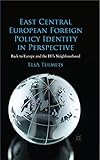East Central European foreign policy identity in perspective : back to Europe and the EU's neighbourhood / Elsa Tulmets.
Material type: TextPublication details: [Basingstoke] : Palgrave Macmillan, (c)2014.Description: 1 online resourceContent type:
TextPublication details: [Basingstoke] : Palgrave Macmillan, (c)2014.Description: 1 online resourceContent type: - text
- computer
- online resource
- 9781137315762
- 9781349331956
- DAW1044 .E278 2014
- COPYRIGHT NOT covered - Click this link to request copyright permission: https://lib.ciu.edu/copyright-request-form
| Item type | Current library | Collection | Call number | URL | Status | Date due | Barcode | |
|---|---|---|---|---|---|---|---|---|
 Online Book (LOGIN USING YOUR MY CIU LOGIN AND PASSWORD)
Online Book (LOGIN USING YOUR MY CIU LOGIN AND PASSWORD)
|
G. Allen Fleece Library ONLINE | Non-fiction | DAW1044 (Browse shelf(Opens below)) | Link to resource | Available | ocn883321338 |
Includes bibliographies and index.
1. Introduction: The 'return to Europe' and the Rediscovery of the East -- PART I: THE 'RETURN TO EUROPE' AND THE DEFINITION OF EAST CENTRAL EUROPEAN FOREIGN POLICY ROLES IN THE EASTERN NEIGHBOURHOO -- 2. The 'return to Europe': Redefining ECE Political Identities After 1989 -- 3. Defining the Historical Self -- 4. East Central European Solidarity and Responsibility Towards the Post-Communist Neighbourhood -- PART II: THE 'EUROPEANISATION' OF FOREIGN POLICY BEHAVIOUR OR THE RECONSTRUCTION OF THE SELF? -- 5. Participation in EU Policies as a Turn in ECE Foreign Policies -- 6. Foreign Policy Consistency Through the Presidencies of the Visegr̀d Group and of the EU Council -- 7. Between Solidarity, Responsibility and Interests: Assistance Policies and Economic Ties -- 8. Conclusion: The Dilemmas of Interpreting Foreign Policy Identity.
Since the fall of the Berlin Wall, countries that previously formed part of the Eastern Bloc have worked on their 'return to Europe' through their accession to traditionally West European supranational institutions such as the European Union and NATO. The book investigates the political and historical foreign policy identities of six of these countries and shows how, despite a clear policy oriented towards the West, the Czech Republic, Estonia, Hungary, Poland, Romania and Slovenia have participated in a differentiated manner in the definition of a European policy towards the Eastern and South-Eastern neighbours. Through analysis of evidence from an original and broad data set, this study highlights that the coherence of EU policy towards the East is mainly linked to its members' capacity to reconcile their political and historical foreign policy identities. The book will be of particular interest to policy-makers, students and specialists of the EU and East Central Europe, as well as to the larger public interested in European integration.
COPYRIGHT NOT covered - Click this link to request copyright permission:
There are no comments on this title.
